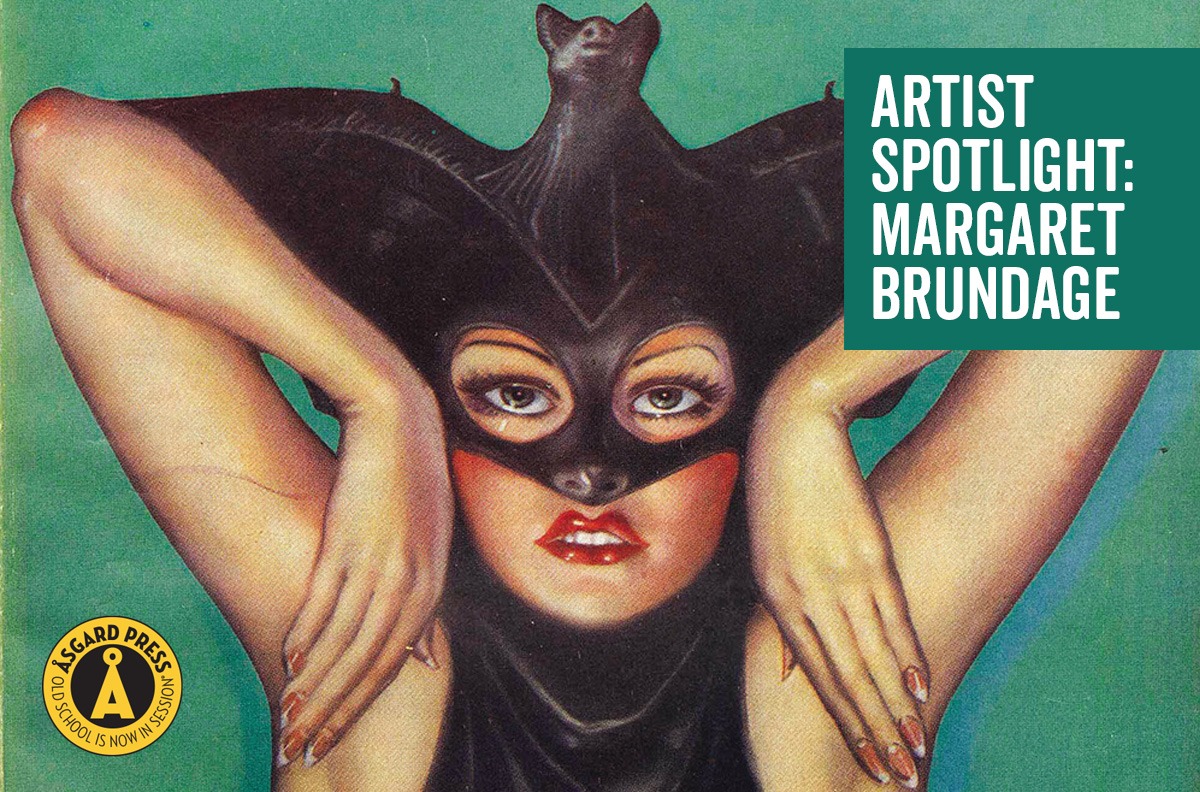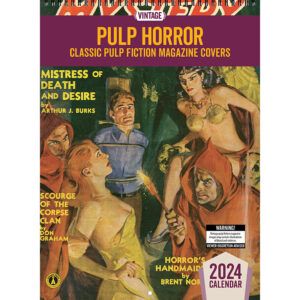Margaret Brundage: Queen of Pulp Horror Illustration
In the early twentieth century when women mainly adhered to traditional gender roles, some stood out for their strength, independence, and pursuit of their passions, and became controversial figures because of it. Margaret Brundage was an American illustrator who broke conventions with her cover art for pulp horror magazines during the 1930s and 1940s. During this time, women rarely worked for pulp publishers, let alone illustrated for the horror genre, but Brundage’s cover work was in demand for its sensational depictions of the stories within the pages of these publications, which were always credited with her initial M rather than her first name. Authors even intentionally inserted scenes into their stories that were conducive to Brundage’s unique style with the hopes of getting their own byline onto the covers of Weird Tales, Brundage’s primary employer. Brundage’s contemporary success, however, was relatively short-lived and came to a crashing end when her publisher let slip to the readership that the cover artist famous for lurid illustrations of scantily clad women facing untold horrors was in fact a woman herself.
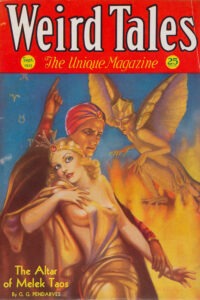
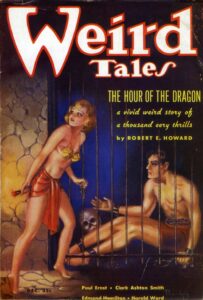
Margaret (Johnson) Brundage was born in 1900 in Chicago, Illinois. Her father passed away while she was still a child, and she was raised by her mother and grandmother. She attended high school alongside fellow aspiring artist Walt Disney and went on to attend Art Institute of Chicago and the Chicago Academy of Fine Arts for fashion illustration, although she fell short of acquiring any degrees. During this time, she also worked as a freelance illustrator for newspapers, interpreting and drawing fashions from written descriptions. To supplement this income, and perhaps to meet like-minded free thinkers, bohemian Brundage also worked at the Dill Pickle Club, a radical Prohibition-era speakeasy known for its affiliation with labor movement agitators. Here she met her husband, Myron Reed “Slim” Brundage, part-time housepainter and full-time labor organizer, writer, poet, and beatnik and joined him in his passion for progressive causes. Their marriage was tumultuous and eventually ended after 12 years and one child together.
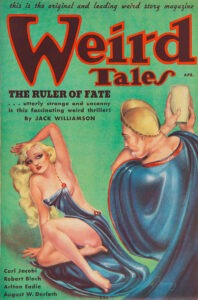
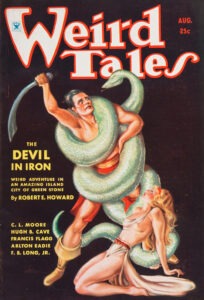
With an absent husband and an ailing mother to care for, Brundage sought out work with Chicago-area publishing companies. During the Great Depression, work anywhere was scarce, and fashion illustrations were no longer in demand, so Brundage turned her artistic hand to pulp magazine cover art. Pulp magazines, called as such due to the cheap, pulpy paper used for the inside pages, were extremely popular from roughly the 1920s to the 1950s because they were affordable forms of entertainment for readers looking for escapism. During times of political, economic, and social upheaval, people often turn to fiction and fantasy to provide a break from the grim realities of life. Horror, suspense, and mystery genres seem to surge in popularity during difficult eras as they can allow readers to process fear and anxiety safely through stories they know to be fiction. It was this particular world of pulp fiction into which Margaret Brundage brought what became her signature style of weird menace illustration.
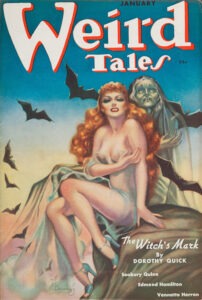
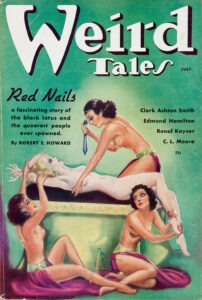
Brundage created most of her cover art for Weird Tales magazine, run by editor Farnworth Wright. Working exclusively in pastels and heavily influenced by her training in fashion, Brundage created female characters that were reminiscent of ethereal pin-ups, which contrasted sharply with the scenes she depicted. Violence, bondage, torture, and nudity were all stock in trade for pulp horror magazines and Brundage became adept at capturing all of it in her controversial cover illustrations. These lurid covers frequently depicted scantily clad women restrained and in distress, or in threatening positions of violent power (and often, both) and elicited protest from many readers for their explicit nature. That explicit nature, however, was what also put Brundage’s Weird Tales covers in high demand. Authors such as Robert E. Howard, Seabury Quinn, and Paul Ernst wrote stories that were perfectly matched to Brundage’s sensational artistic interpretation with the aim of securing each issue’s cover for their tales. Brundage created 66 covers for Weird Tales, roughly half of which ran consecutively from 1933 to 1936, with the signature “M. Brundage.” Few people knew that the startling and provocative art on these covers was created by a woman, as it was unheard-of at the time.
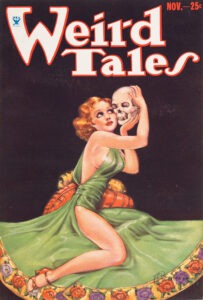
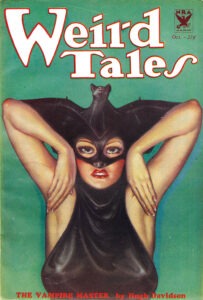
As controversial as Brundage’s Weird Tales artwork was for its racy and salacious content, it became downright scandalous when editor Farnsworth Wright publicly revealed the identity of M. Brundage as a woman, done in an attempt to soften outcry over the lurid illustrations on his publication’s covers. In a further blow to Brundage’s career, the publisher of Weird Tales relocated to New York, where “decency” standards prohibited the public display of the explicit illustrations upon which she had built her body of work. This, coupled with the logistical problems of transporting her fragile pastel originals from Chicago to New York, spelled the end of Brundage’s relationship with Weird Tales and her commercial work dwindled, though she continued to create artwork in an independent capacity until her death in 1976.
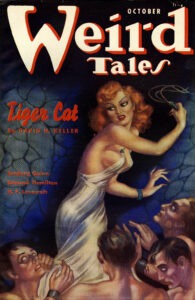
Brundage’s artwork has recently been reexamined under a modern lens by horror, science fiction, and fantasy fans and her influence on the subsequent artists of these genres has been definitively acknowledged. Her unique artistic aesthetic, guided by her foundation in fashion and her commitment to a bohemian lifestyle, set the standard for depicting “damsels in distress” that has persisted in pop culture in the years following her tenure in the pulp industry. Though some may criticize Brundage for perpetuating the “women in peril” trope, her success as a woman in the genre and her simultaneous portrayal of violently powerful female characters belies this sentiment. Margaret Brundage has been crowned “Queen of the Pulps” by her fans and this title is reflected in the value collectors have placed on her work today, with originals selling for tens of thousands of dollars at auction. Though her artwork may not meet decency “standards” (we’re looking at you, Fiorello La Guardia), it has left an indelible mark on pop culture and opened doors for female artists entering traditionally male dominated genres. Brundage may have died in relative obscurity, but her legacy remains visible today.
If you would like to see more pulp horror magazine covers by a variety of artists, check out our 2024 Vintage Pulp Horror Calendar, featuring 13 art-quality prints of pulp horror covers from the Golden Age of pulps.

